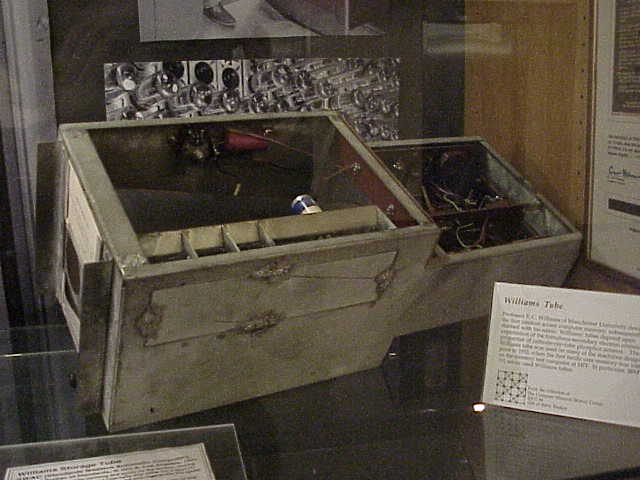 | Floor 2 |
 |
 |

|
 |
 |
 |
 | Floor 2 |
 |
 |

|
 |
 |
 |
Grace Hopper started as the first programmer in 1944, on the Mark I (IBM ASCC), based on the work of Professor Howard H. Aiken of Harvard. It is a relay-based computer. The Common Business-Oriented Language (COBOL) was defined in 1959 by the Conference on Data System Languages (Codasyl), based on Grace Hopper's Flow-Matic. By 1960 COBOL was available on the UNIVAC II and the RCA 501. Eventually it will become available on all large and mid-sizxe computers and account for more than half of all computer programs in service.
 |
The Eckert-Mauchly Computer Corporation was formed in 1946, it became the Electronic Control Co. to design a Universal Automatic Computer (Univac). J. Presper Eckert and John W. Mauchly had worked on ENIAC since 1944. ENIAC was originally programmed by plug-in wires, at the Moore School of the University of Pennsylvania. They left in 1946 because of disputes with University regarding patents and with von Neumann regarding credit for the concept of stored computer programs for a successor machine, EDVAC. ENIAC was also eventually updated to store programs, by 1948?
Quote from an
interview in 1988, may pertain to sa similar module:
In 1950 Remington-Rand acquired the Eckert-Mauchly Computer Corp. In 1955 Remington-Rand merged with Sperry Gyroscope to form Sperry-Rand. In 1986 Burroughs merged with Sperry to form Unisys Corporation, second only to IBM in computer revenues.
 |
 |
 |
 |
 |
 |
SWAC was located at the National Bureau of Standards, in Los Angeles, 1951, and when the NBS office was closed (due to pressure from Senator McCarthy) moved to UCLA in 1953. It was the first major computer in the Western U.S.A. Computation on SWAC was charged out at $40.- per hour. It remained in use to 1962, eventually for conversion of data for the new IBM 7090 being acquired by WDPC (Western Data Processing Center) at UCLA.
Storage is achieved by painting 16x16 spots on the screen of the tube. During writing emissions are generated internally that differ for a spot (1) versus a blank (0). These are used to read and regenerate the spots every 8 microseconds. Changing a spot took two cycles. A complete fixed-point addition took 64 microseconds, a multiplication 384 microseconds. In 1950 it was the fastest computer in the world [Harry Huskey, his Story; Book Surge Publishing, 2004].
Presper Eckert compared the concept of regeneration to a boy
repeating a shopping list over and over on the way to the store, using
his short-term memory to create a long-term memory.
The base concept of regeneration, immediatly writing what is destructively
read, came from the work of An Wang at Harvard in 1949. IBM later licensed the
concept, allowing Wang to support his own computer company, Wang Laboratories.
SWAC had 40 of these tubes, for a total memory capacity of 256
words of 40 bits each. It also had a 8,192 word drum. It used 2,500
vacuum tubes and 4,000 diodes. Its 25 minute mean-time-between
failures made it relatively reliable for its time(1956).
A history of storage devices,
starting in 1928, shows the Williams tube as built by Prof. Fredrick C. Williams of Manchester, and also a 1928 magnetic drum [webpage of a Cloud business, as suggested by Tom Coner, of Vermont].
Prof.
Harry Huskey, who had worked on ENIAC in 1945 and
later on the Pilot ACE at the British National Physics Laboratory,
designed the
SWAC in 1949-1953.
He moved to UC Berkeley in 1953.
Consulting for Bendix, Harry Huskey helped design the Bendix G-15 and G-20
computers. The G-15 was based on plans made by Huskey prior to the building
of the SWAC; it was completed in 1956.
The Bendix G-15 used a magnetic drum instead of Williams tubes. Timing of
operations to match memory availability remained crucial.
Joe Weizenbaum, as a graduate student from Wayne State Univ., improved the
floating-point interpreter for that machine, so that the programming user
did not have to worry about the timing. Weizenbaum eventually joined the
MIT CS department, and became well-known for his Eliza program.
The Bendix Computer divison was sold to CDC in 1963.
At UC Berkeley Prof. Huskey co-advised with Prof. Feigenbaum a Philosophy student Bruce Buchanan, both later moved to Stanford. Huskey also brought Gio Wiederhold from IBM to UC Berkeley in 1960; and then sponsored him for a stay at IIT Kanpur. Ed Feigenbaum in turn brought Gio to Stanford in 1965, initially to develop the ACME Time-shared Computer System for the Stanford Medical School.
Harry Huskey in 1966 moved to UC Santa Cruz and founded their Computer Science Department, retiring in 1986.
 | Floor 2 |
 |
 |

|
 |
A nice collection of historical pictures, including pictures of the ENIAC, one showing Prof. Huskey, is at the Army Research Lab's Historical collection.